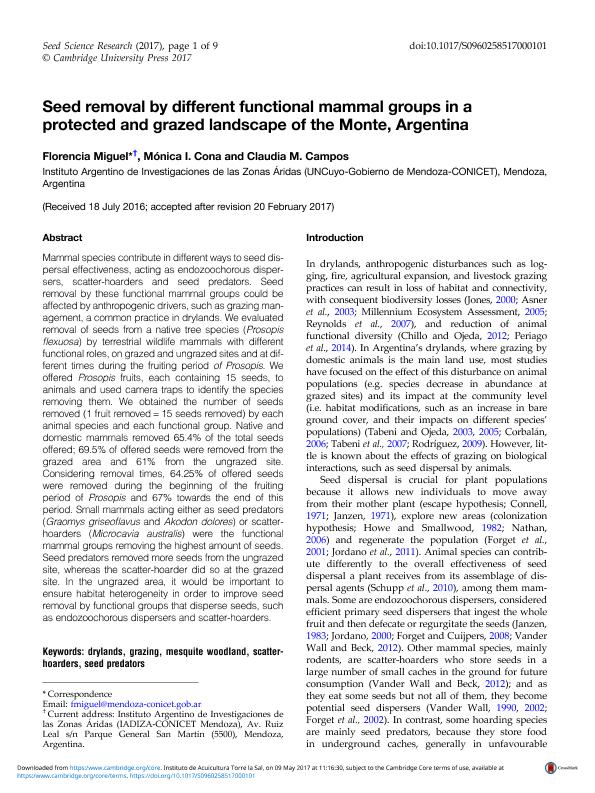Artículo
Seed removal by different functional mammal groups in a protected and grazed landscape of the Monte, Argentina
Fecha de publicación:
09/2017
Editorial:
Cambridge University Press
Revista:
Seed Science Research
ISSN:
0960-2585
Idioma:
Inglés
Tipo de recurso:
Artículo publicado
Clasificación temática:
Resumen
Mammal species contribute in different ways to seed dispersal effectiveness, acting as endozoochorous dispersers, scatter-hoarders and seed predators. Seed removal by these functional mammal groups could be affected by anthropogenic drivers, such as grazing management, a common practice in drylands. We evaluated removal of seeds from a native tree species (Prosopis flexuosa) by terrestrial wildlife mammals with different functional roles, on grazed and ungrazed sites and at different times during the fruiting period of Prosopis. We offered Prosopis fruits, each containing 15 seeds, to animals and used camera traps to identify the species removing them. We obtained the number of seeds removed (1 fruit removed = 15 seeds removed) by each animal species and each functional group. Native and domestic mammals removed 65.4% of the total seeds offered; 69.5% of offered seeds were removed from the grazed area and 61% from the ungrazed site. Considering removal times, 64.25% of offered seeds were removed during the beginning of the fruiting period of Prosopis and 67% towards the end of this period. Small mammals acting either as seed predators (Graomys griseoflavus and Akodon dolores) or scatter-hoarders (Microcavia australis) were the functional mammal groups removing the highest amount of seeds. Seed predators removed more seeds from the ungrazed site, whereas the scatter-hoarder did so at the grazed site. In the ungrazed area, it would be important to ensure habitat heterogeneity in order to improve seed removal by functional groups that disperse seeds, such as endozoochorous dispersers and scatter-hoarders.
Palabras clave:
Drylands
,
Grazing
,
Mesquite Woodland
,
Scatter-Hoarders
,
Seed Predators
Archivos asociados
Licencia
Identificadores
Colecciones
Articulos(IADIZA)
Articulos de INST. ARG DE INVEST. DE LAS ZONAS ARIDAS
Articulos de INST. ARG DE INVEST. DE LAS ZONAS ARIDAS
Citación
Miguel, María Florencia; Cona, Monica Ines; Campos, Claudia Monica; Seed removal by different functional mammal groups in a protected and grazed landscape of the Monte, Argentina; Cambridge University Press; Seed Science Research; 27; 3; 9-2017; 174-182
Compartir
Altmétricas




